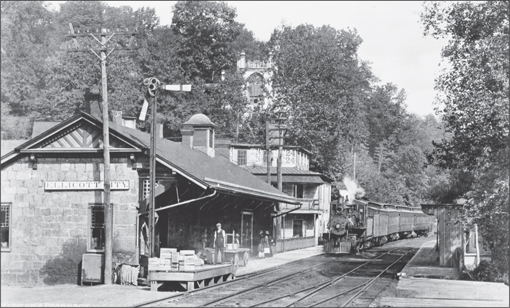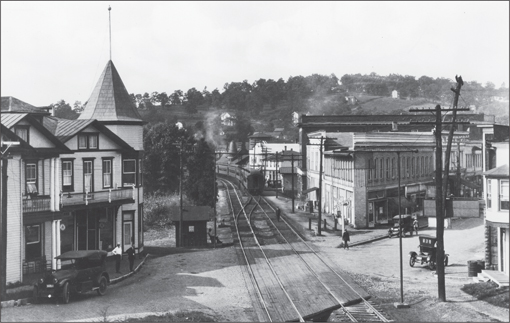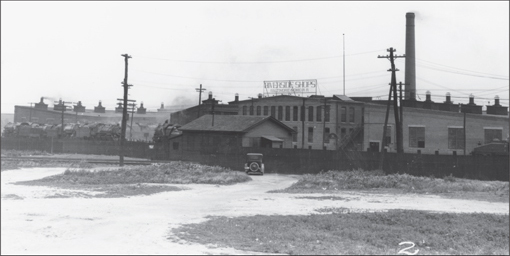Four
A NEW CENTURY
AND PROSPERITY
1900–1927
The first quarter of the 20th century was a time of recovery and prosperity for the B&O. Nationally, its line continued to grow. It formally added stops to Cincinnati and St. Louis and, for a brief period, had direct access to New York. Overall, the system benefited from increased freight and passenger traffic. In part, this was due to increased traffic during World War I, but it also benefited from postwar optimism.
Locally, the century began in devastating fashion, as the B&O’s Baltimore headquarters was destroyed in the great fire of 1904. The railroad would rebuild a new General Office building and expand its Baltimore port facilities at Locust Point and Curtis Bay. The B&O even introduced the employee magazine, with operations centered in Baltimore. Stations along the Washington and Metropolitan branches were still rural by modern standards, and many of the surrounding localities would not be recognizable today.
The railroad upgraded its infrastructure, passenger service, and locomotive fleet. It is during this time that two of the B&O’s premier passenger trains trace their beginnings. The Capitol Limited operated through Maryland from Washington, DC, to Chicago, and the National Limited operated from New York to St. Louis. Both were all-Pullman lines and provided excellent accommodations. Heavier, faster, and more powerful locomotives entered service, like the Mikado, and the yards along the line, like Brunswick, Cumberland, and Mount Clare, were heavily active supporting operations.
In 1910, Daniel Willard took over the helm of the B&O. He proved to be as strong a leader, and as legendary a figure, as John Garrett, guiding the railroad until his retirement in 1941. From 1910 to 1927, he oversaw a golden age of prosperity and the heyday of steam power on the B&O. This period culminated with the celebration of the 100th anniversary of the B&O and of railroading in America.

These photographs of the Ellicott City station show the east and west approaches. Above, an eastbound passenger train approaches the station in the early 1900s. This widely recognized image shows changes to the station. The east end of the building once housed a car shop, and locomotives were stored inside. The doors were removed with the changes over time, and the once important turntable is no longer visible. Below, a westbound train approaches the platform with waiting passengers. The building on the right in the foreground was originally known as the Patapsco Hotel. In the early days of railroading, passengers purchased their tickets and boarded the train from the hotel, since the depot was used for freight until it was modified to accommodate both passenger and freight service in 1857.


On February 7, 1904, a devastating fire destroyed over 1,000 buildings constituting the majority of Baltimore’s downtown financial district. The fire gutted the B&O’s central headquarters. The most important records were able to be saved before the fire reached the building, but a considerable amount of information about the B&O’s operations and history were lost in the fire.

In September 1906, Baltimore celebrated its recovery from the 1904 fire, and the B&O participated. The festivities included three parades on consecutive days. The first included a military procession. The second was an industrial procession that included 6,000 B&O employees. The third parade consisted of a large contingent of firefighters from localities that helped combat the blaze. This postcard shows B&O workers marching in formation.

A celebration was held in front of the B&O’s new General Office building, erected two blocks west of the headquarters destroyed in the 1904 fire. This is more than likely the opening ceremony for the office building, which cost $2.4 million and was constructed in the shape of an “H” for maximum light and ventilation. It contained 250,000 square feet, 5.5 acres of floor space for offices, ornate lobbies, and 1,784 windows.

The B&O’s shop staff gathers outside a roundhouse at Riverside in the early 1900s. An “X” marks the location of Joseph Irwin Say. Born in 1887, Say was in his teens when this photograph was taken. He served as an apprentice. The workers are sitting between elliptical and leaf springs, used as suspension rigging on railroad wheel sets, seen at right.

Purchased by the B&O in 1905, this building was located on Virginia Avenue in Cumberland and served as the B&O YMCA. Railroaders and train crews in particular used its services as a clean and safe place to stay. In addition to rooms and baths, it contained an auditorium for shows and religious services. It closed in 1967.

Located in Allegany County, the Cumberland Narrows lie just northwest of Cumberland. Originally an Indian path, it was used by General Braddock on his ill-fated attempt to remove the French from the Ohio River Valley in the 1750s. It also served as the route of the National Road, and eventually, it would see the B&O’s line west.

This 1912 photograph of Camden Station emphasizes the sheer size of the site and associated operations. Located behind the main building are the covered train platforms. The freight offices and warehouse extend down the western side of the building. In the upper right is Bailey’s Roundhouse, located on the corner of Ostend, Eutaw, and Stockholm Streets.

By all accounts, Lansdowne was a B&O town. The depot was listed on early maps as Coursey Station because it sat on the property of William Coursey. This postcard image shows the station as it appeared in 1912. It served as a commuter station, and many of the local residents worked for the railroad.

This c. 1915 photograph provides a view of the B&O’s Aberdeen station on the line to Philadelphia. Built in 1885, the station still exists but is in poor condition. It was condemned and slated for destruction, but the Historical Society of Harford County, Inc., is leading efforts to save and restore it.

A passenger train pulls past the Oakland station around 1915. This wonderful photograph shows the relationship of the station and its activities to a bustling town. The grade crossing lacks crossing gates, but it does have a flagman’s booth, the small shack next to the tracks.

A B&O freight train travels along the C&O Canal in western Maryland. The canal and the railroad were bitter rivals when both began in the late 1820s. Competing for traffic, resources, funding, and geography, both felt they were the future of transportation in the state and crucial to the success of the local economy. The railroad and the canal competed with each other for many years, until the canal was purchased by the B&O.

These 1920s photographs of the B&O’s Oliver Viaduct show three avenues of transportation meeting in Ellicott City. The above photograph looks west toward Ellicott City from the Baltimore County side of the Patapsco River. The viaduct, completed in 1830, had three stone arches, one over the Tiber River and two over Main Street. The arches over Main Street were replaced with a steel span in the early 1900s. To the right in the above photograph is the bridge for trolley line No. 9, which shuttled commuters between Ellicott City and Baltimore from the late 1890s until 1955. It was a more direct route than the B&O’s main line. The photograph below looks east toward the river. The bar on the right sat on the corner of Maryland Avenue and Main Street. Here, it blocks the view of the 1831 depot.


The B&O’s Gaithersburg station (above) and freight house (left) along the Metropolitan branch are seen in these 1920s photographs. Another Baldwin-designed building, the station was a bustling commuter location and served the local milling industry. The railroad operated local trains between Washington and this stop, and there were as many as 30 trains stopping or continuing through here in the early 1900s. Today, the station still stands and is used as a MARC stop for commuters and the site of a small coffee shop, Java Junction. The freight house contains the Gaithersburg Community Museum, which features rotating and permanent exhibits on the railroad and development of the town. In addition to a steam engine and caboose, the museum recently acquired a self-propelled B&O passenger BUDD car from the B&O Railroad Museum.


A passenger waits to board at Camden Station in the 1920s. It is probable that she will be riding the Capital Limited, an all-Pullman train traveling between Washington, DC, and Chicago. Sleeper cars would stop at Camden and then join the Capital Limited in Washington. The young African American man at left is a red-cap baggage handler waiting to assist passengers.

Daniel Willard (1861–1942) was one of America’s key railroad figures in the 20th century, serving as B&O president for 31 years. His progressive management style and ability to relate with workers allowed him to successfully guide the B&O during its golden age and through the Great Depression. A close advisor to presidents and respected by labor unions, Willard was affectionately known as “Uncle Dan.”

In the photograph above, employees of the B&O’s Riverside machine shop gather in front of and on a locomotive in the roundhouse on February 27, 1925. The roundhouse was one of two located at the Riverside Shops, built in 1907 to handle locomotive servicing. The “X” marks the location of Joseph Irwin Say (third row, fifth from right). The photograph below shows the shops in the 1920s, about the time the workers posed for their photograph. One of the roundhouses is located to the left. While the yard still exists, the roundhouses have been removed. Riverside was the site of CSX and MARC operations for many years. CSX ended its presence in 2013. MARC outsourced passenger operations the same year, selling the facility to Bombardier.


One of the most noted female civil engineers of her time, Olive Dennis (1885–1957) broke many barriers in her distinguished career. The second woman to graduate from Cornell University’s engineering program, she began her career in 1920 and quickly impressed management. Dennis eventually answered directly to Pres. Daniel Willard. Among her recommendations and design changes to passenger cars were stain-resistant seats, reclining seats, dimming lights, and overall air-conditioning of coaches.

The B&O’s new locomotive, President Washington (No. 5300), is on display in front of the Mount Clare grain elevator on March 27, 1927. The engine was the first of 20 class P-7 Pacific-type locomotives built for the B&O by Baldwin Locomotive Works in 1927. These locomotives were named after the first 21 US presidents. A single President Adams represented both John and John Quincy Adams.

Mount Royal Station is seen above in 1927. In the photograph below, the vestibule of the observation car is packed with passengers on the B&O’s Capitol Limited as it prepares to head south through the Howard Street Tunnel. The Capitol Limited was the B&O’s premier train when it began service in 1923 between New York City and Chicago. While the line could not compete with the speedier passenger trains of the Pennsylvania Railroad and the New York Central, it was known for the quality of its service. The luxurious all-Pullman sleeper-car train featured amenities such as a barber, manicurists, maids, and secretaries. Passengers enjoyed fine cuisine on diners such as the Martha Washington. Today, the Capitol Limited is one of Amtrak’s premier trains, operating between Washington, DC, and Chicago.
























